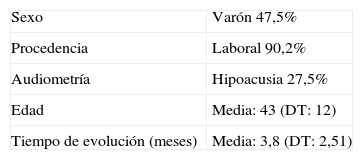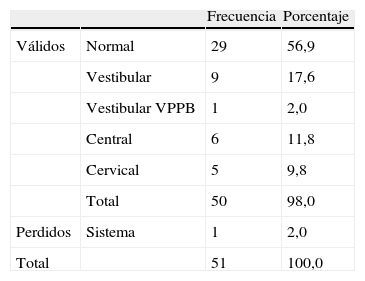El vértigo y la inestabilidad tienen una importante implicación médico-legal en el paciente con antecedente de latigazo cervical (LC). En estos casos la posturografía dinámica computarizada (PDC) aporta información adicional a las pruebas vestibulares estándar y tiene descritos patrones compatibles con escasa colaboración o falta de sinceridad al esfuerzo, también denominados afisiológicos. El objetivo de este trabajo es valorar las características de las pruebas de equilibrio y función vestibular en pacientes con LC y especialmente, los resultados afisiológicos.
Material y métodosEstudio retrospectivo de pacientes con antecedente de LC con vértigo y/o inestabilidad. Se realizó videonistagmografía (VNG) y PDC. Los resultados de la prueba de organización sensorial (SOT) se valoraron como normales, vestibulares o afisiológicos usando el método de cálculo publicado por Cevette et al. en 1995.
ResultadosCincuenta y uno pacientes (24 varones, 27 mujeres); edad media: 42,2 años; tiempo de evolución medio: 3,8 m; PDC afisiológica: 13 (25,5%); PDC vestibular: 9 (17,6%); PDC normal: 29 (56,9%); VNG normal: 29 (56,9%); VNG alterada: 22 (43,1%); VNG vestibular: (n=11); VNG central: (n=6), y VNG cervical: (n=5). En el 46,2% de pacientes con PDC afisológica la VNG estaba alterada.
ConclusionesLa prevalencia de pruebas afisiológicas en la PDC en el LC es relativamente elevada sin que deba suponerse simulación o exageración ya que en muchos casos existen signos objetivos de disfunción vestibular. Sería recomendable realizar pruebas de función vestibular a los pacientes con LC con síntomas vertiginosos. La rehabilitación vestibular podría ser de utilidad en estos casos.
The medical legal implications of dizziness and imbalance among patients with whiplash-associated disorders (WAD) are important. In these cases, Computerized Dynamic Posturography (CDP) provides information to standard vestibular tests and patterns consistent with scarce collaboration or lack of sincerity on efforts have been described.
ObjectivesThis work has aimed to assess the prevalence of altered balance and vestibular function tests in patients with whiplash injury, and especially the aphysiologic results.
Material and methodsA retrospective review of patients with whiplash injury referred for assessment of dizziness and/or imbalance was carried out. Standard videonistagmophgraphy (VNG) assessment including CDP was performed in all patients. The Sensory Organization Test (SOT) summaries were scored as normal, aphysiologic, or vestibular using the scoring method published by Cevette et al. in 1995.
ResultsThe study included 51 patients (24 men, 27 women) with mean age: 42.2 years. Mean evolution time was 3.8 m. Aphysiologic CDP 13 (25.5%); vestibular CDP 9 (17.6%); normal CDP 29 (56.9%). Normal VNG 29 (56.9%); altered VNG in 22 (43.1%): vestibular VNG (n=11); central VNG (n=6); cervical VNG (n=5). VNG was altered in 46.2% of patients with aphysiologic CDP.
ConclusionsThe prevalence of aphysiologic results on CDP among whiplash injury patients is relatively high, however, this should not necessarily be consider to be related to malingering or exaggeration since objective signs of vestibular dysfunction are found in many cases. Thus, we recommend these tests should be done in whiplash injury patients complaining of dizziness and imbalance. Vestibular rehabilitation could be of interest in the recovery of these patients.
Artículo
Comprando el artículo el PDF del mismo podrá ser descargado
Precio 19,34 €
Comprar ahora














